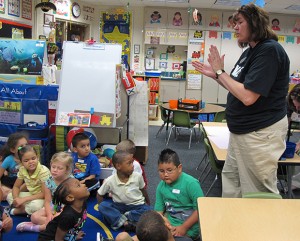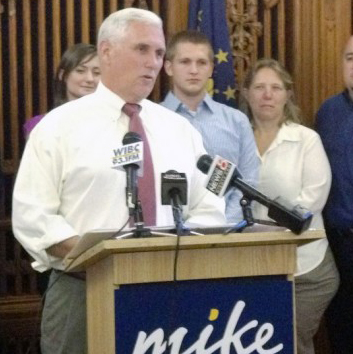A Closer Look At Mike Pence's and John Gregg's Pre-K Plans

Elle Moxley / StateImpact Indiana
A teacher leads young children at a summer camp designed to help students who didn't take preschool classes get ready for kindergarten.
Indiana gubernatorial candidates Mike Pence and John Gregg both understand the problem:
Nearly half of all preschool-aged children in Indiana do not attend preschool — a rate topped by only six other states — even though many agree early childhood education is the best way to ensure a student succeeds in school as they grow.
Both candidates say something must be done to get more Indiana children into early childhood education programs. But is it the state’s role to provide them?
Gregg, the Democratic candidate, says yes:
- He points out Indiana is one of 11 states that doesn’t fund a Pre-K program.
-

Gregg says — absent a state-run option — middle-income families have few options for preschool available, as those who have incomes just high enough not to qualify for the federal Head Start program still often don’t make enough money to provide for private preschool.
- Gregg wants to start a state-run Pre-K pilot program in 40 schools. The pilot would run for two years.
- Gregg does not know how much his pilot program would cost. Officials could collect data from the pilot program, then extrapolate how much a statewide program might cost. Outside estimates peg the likely cost at somewhere between $3,500 and $5,000 per student.
- He says the key is in catalyzing the state’s existing private and non-profit Pre-K providers into offering more services for underprivileged students.
- Pence doesn’t know whether these incentives would come in the form of vouchers, tax subsidies, or another funding source. He says that’s a proper question for the General Assembly.
- Pence says there’s “already a pilot program across Indiana” with Pre-K programs such as Busy Bees Academy in Columbus, which is funded with a mix of public and private money.
- Pence says faith-based, private and non-profit organizations provide an “indigenous” infrastructure for expanding services.
Indiana University’s Center for Evaluation and Education Policy (CEEP) wrote in 2006 that providing half-day Pre-K for the nearly 20,000 “at-risk” four-year-olds would cost the state between $68 million and $96 million. While Gregg’s pilot program would likely cost a fraction of that total at first, Indiana lawmakers have told StateImpact the state simply cannot afford it.
CEEP director Jonathan Plucker says lawmakers understand the benefits of Pre-K, but are limited by the expense and expanse of a statewide program.
“It’s a wise investment. It’s a fiscally conservative investment,” Plucker told StateImpact, adding, “but it just costs money. Even after people in the state of Indiana across the aisle decided that full-day kindergarten was a good thing. It took us years to get the funding in place.”
By a “conservative” estimate, the authors of the 2006 CEEP paper add, such a program would come with a $273 million return-on-investment for the state “in saved educational, social, and legal costs over the students’ lifetimes.”
Read our full interviews with Mike Pence and John Gregg — they spoke to StateImpact on a wide variety of education issues.




